A Mini-Review on CO2 Photoreduction by MgAl-LDH Based Materials
Abstract
1. Introduction
2. Theory of CO2 Photoreduction
2.1. Basic Concepts of Photocatalysis
2.2. Performance Evaluation and Influencing Factors of CO2 Photoreduction
2.3. Reaction Process of CO2 Photoreduction
3. Structures and Properties of MgAl-LDH
3.1. Component and Characteristic of LDH Materials
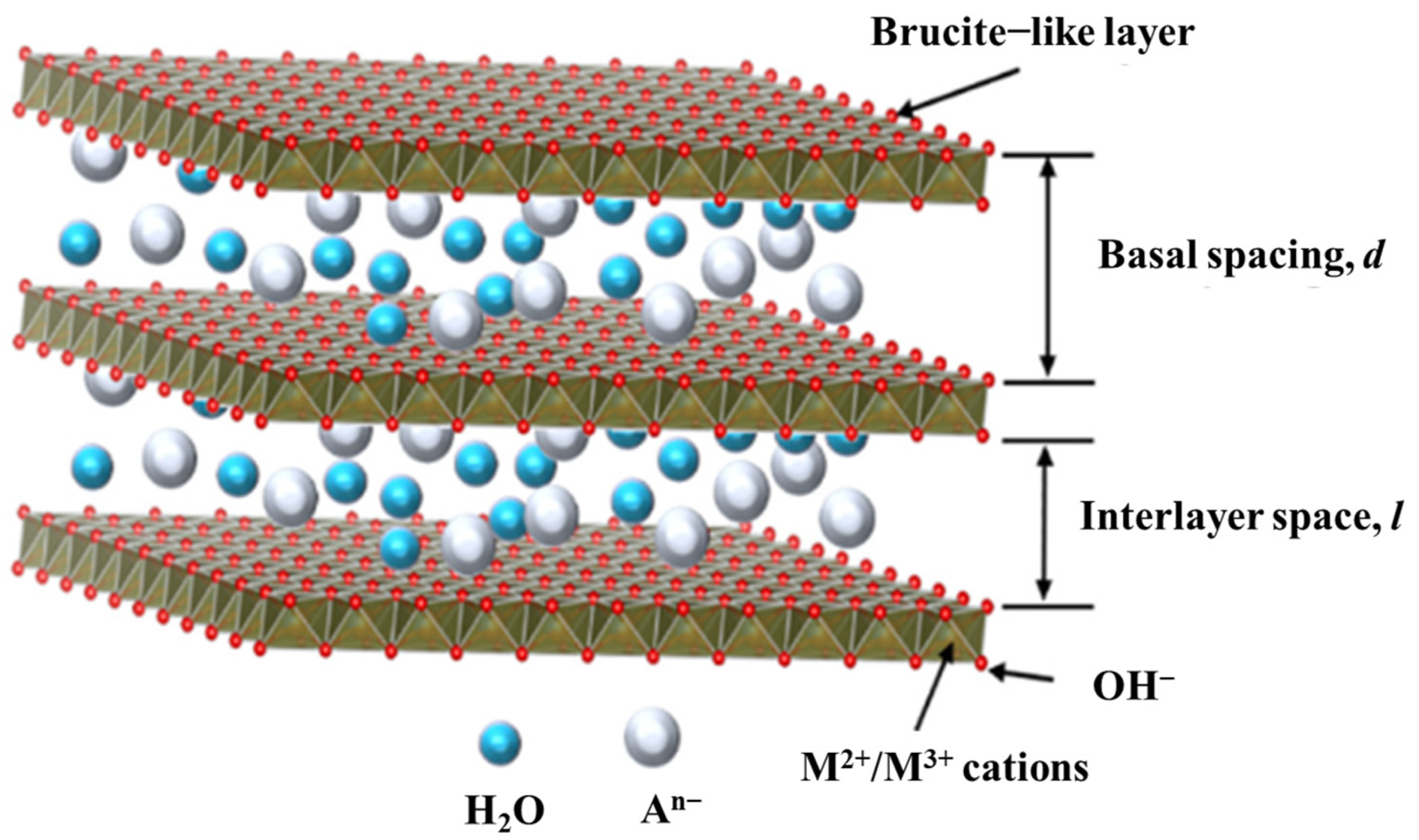
3.2. Advantages of MgAl-LDH for CO2 Photoreduction
3.2.1. Tunable Composition for Demand
3.2.2. Outstanding CO2 Adsorption Performance
3.2.3. Layer Structure for Construction of Composite Catalysts
3.3. Drawbacks of MgAl-LDH
3.3.1. Wide Bandgap of MgAl-LDH
3.3.2. High Recombination Rate of Electron–Hole Pairs
4. CO2 Photocatalytic Reduction by MgAl-LDH-Based Materials
4.1. The Introduction of Active Components into MgAl-LDH
| Catalyst | Synthesized Method | Reaction System | Light Source | Type of Reactor | Reaction Condition | Product Yield (μmol·g−1·h−1) | Selectivity | Ref. |
|---|---|---|---|---|---|---|---|---|
| MgAl-LDH | Coprecipitation | Cl− + H2O | 400 W Hg lamp (UV light) | 220 mL closed circulating system | 7.7 mmol CO2 + 350 mL H2O | CO = 0.6 CH4 = 0.3 H2 = 1.2 | CO: 28.6% CH4: 14.3% H2: 57.1% | [74] |
| MgAl-LDH | Microwave-hydrothermal | - | 150 W Xe lamp (Simulated sunlight) | 200 mL stainless cylindrical reactor | - | CO = 1.3 CH4 = 0.1 | CO: 92.9% CH4: 7.1% | [68] |
| Fluorinated MgAl-LDH | Coprecipitation | Cl− + H2O | 400 W Xe lamp (UV light) | Quartz inner-irradiation reactor | 7.6 mmol CO2 + 350 mL H2O | CO = 4.3 H2 = 10.5 | CO: 29.1% H2: 70.9% | [70] |
| MgAlTi-LDH | Coprecipitation | H2O | 400 W UV lamp (200–1000 nm) | Continuous-flow quartz tube reactor | CO2 + 2.3 vol.% H2O + 150 °C | CO = 10 (per gram of TiO2) | - | [90] |
| CoMgAl-LDH | Coprecipitation | [Ru(bpy)3]Cl2·6H2O + TEOA + MeCN + H2O | 300 W Xe lamp (>400 nm) | 50 mL stainless reactor | 1.8 bar + 30 °C | CO = 7700 H2 = 5808.8 | CO: 57.0% H2: 43.0% | [85] |
| CrMgAl-LDH | Hydrothermal | [Ru(bpy)3]Cl2·6H2O + TEOA + H2O | 300 W Xe lamp (420–780 nm) | 250 mL quartz reactor | 0.1 MPa CO2 + 20 °C | CO = 3.91 H2 = 2.05 | CO: 65.6% H2: 34.4% | [48] |
| Ultrathin MgAl-LDH | Titration | [Ru(bpy)3]Cl2·6H2O + TEOA + MeCN + H2O | 300 W Xe lamp (400–800 nm) | 50 mL stainless reactor | 1.8 bar | CO = 700 H2 = 1700 | CO: 29.2% H2: 70.8% | [91] |
| Ru/ultrathin MgAl-LDH | Impregnation | H2 | 300 W Xe lamp | Flow photoreactor | 5 mL·min−1 CO2 + 20.5 mL·min−1 H2 + ~350 °C | CH4 = 2.77 × 105 | CH4: ~100% | [77] |
| Monolayer MgAl-LDH | SNAS | [Ru(bpy)3]Cl2·6H2O + TEOA + MeCN + H2O | 300 W Xe lamp (>400 nm) | 50 mL stainless reactor | 1.8 bar + 30 °C | CO = 170 H2 = 210 | CO: 44.7% H2: 55.3% | [92] |
| Pt/MgAl-LDH | Electrostatic attraction | H2O | 300 W Xe lamp (UV light) | 250 mL quartz reactor | 0.1 MPa CO2 + 20 °C | CO = 2.64 CH4 = 0.2 | CO: 93.0% CH4: 7.0% | [67] |
| Ag/Ga2O3/MgAl-LDH | Coprecipitation | NaHCO3 | 400 W Hg lamp (UV light) | Flowing batch system | 30 mL·min−1 CO2 + Room temperature | CO = 211.7 H2 = 131.4 | CO: 61.7% H2: 38.3% | [93] |
| CeO2/MgAl-LDH | Hydrothermal | [Ru(bpy)3]Cl2·6H2O + TEOA + MeCN + H2O | 300 W Xe lamp (Visible light) | 1.8 bar + 30 °C | CO = 85 H2 = 110.5 | CO: 42.1% H2: 57.9% | [94] | |
| Fe3O4/MgAl-LDH | Coprecipitation | NaOH + MeCN + H2O | 8 W UV light | 300 mL quartz reactor | 0.1 MPa CO2 + 20 °C | CO = 442.2 CH4 = 223.9 | CO: 68.9% CH4: 31.1% | [83] |
| Co-TCPP@MgAl-LDH | Esterification | H2O | 300 W Xe lamp (420–780 nm) | 250 mL quartz reactor | - | CO = 0.13 CH4 = 0.08 | CO: 62.0% H2: 38.0% | [95] |
| Pd/C3N4/MgAl-LDH | Self-assembly | H2O | 500 W Hg-Xe lamp (UV light) | 0.03 MPa CO2 + Room temperature | CH4 = 0.7 | - | [73] | |
| Pt/MgAl-LDO/TiO2 | Coprecipitation | H2O | 300 W Xe lamp (260–400 nm) | Closed circulating system | 0.1 MPa CO2 + 40 mL H2O + 20 °C | CO = 1.5 CH4 = 2.3 | CO: 39.5% CH4: 60.5% | [96] |
| MgAl-LDO/Nv-CN | In situ deposition | H2O | 300 W Xe arc lamp (>400 nm) | 280 mL double-necked reactor | - | CO = 20.47 | - | [97] |
| Fe/MgAl-LDO | Thermal reduction | H2 | 300 W Xe lamp (200–800 nm) | 50 cm3 stainless reaction chamber | 1.8 bar + CO2/H2/Ar = 15/60/25 + ~275 °C | CO2 conversion = 50.1% | CO: 16.0% CH4: 49.5% C2–4: 31.2% C5: 3.3% | [98] |
| MgAl-LDO/TiO2 | Coprecipitation | H2O | 100 W Hg lamp (<390 nm) | Continuous-flow quartz tube reactor | 4.5 mL·min−1 He with H2O + 200 °C | CO = 99 μmol·g−1 | - | [99] |
| MgAl-LDO/TiO2 | Hydrothermal | H2O | 100 W Hg lamp (<390 nm) | Continuous-flow quartz tube reactor | 4.5 mL·min−1 CO2 with 2.3 vol.% H2O + 150 °C | CO = 4.3 | - | [100] |
| TiMgAl-LDH/GO | Coprecipitation | H2O | 300 W Xe lamp (>420 nm) | 50 cm3 stainless reactor | 0.08 MPa | CO = 4.6 CH4 = 3.8 | CO: 54.8% CH4: 45.2% | [101] |
4.2. Morphology Control of MgAl-LDH
4.3. Supported Active Components over MgAl-LDH
4.4. MgAl-LDH as Precursor for Catalyst Preparation
4.5. Construction of Heterojunction
5. Conclusions and Perspectives
Funding
Data Availability Statement
Conflicts of Interest
References
- Hoegh-Guldberg, O.; Mumby, P.J.; Hooten, A.J.; Steneck, R.S.; Greenfield, P.; Gomez, E.; Harvell, C.D.; Sale, P.F.; Edwards, A.J.; Caldeira, K.; et al. Coral Reefs under Rapid Climate Change and Ocean Acidification. Science 2007, 318, 1737–1742. [Google Scholar] [CrossRef] [PubMed]
- Albright, R.; Caldeira, L.; Hosfelt, J.; Kwiatkowski, L.; Maclaren, J.K.; Mason, B.M.; Nebuchina, Y.; Ninokawa, A.; Pongratz, J.; Ricke, K.L.; et al. Reversal of ocean acidification enhances net coral reef calcification. Nature 2016, 531, 362–365. [Google Scholar] [CrossRef]
- Yang, Y.; Cao, J.; Hu, Y.; Sun, J.; Yao, S.; Li, Q.; Li, Z.; Zhou, S.; Liu, W. Eutectic doped Li4SiO4 adsorbents using the optimal dopants for highly efficient CO2 removal. J. Mater. Chem. A 2021, 9, 14309–14318. [Google Scholar] [CrossRef]
- Pacala, S.; Socolow, R. Stabilization Wedges: Solving the Climate Problem for the Next 50 Years with Current Technologies. Science 2004, 305, 968–972. [Google Scholar] [CrossRef]
- Din, I.U.; Shaharun, M.S.; Alotaibi, M.A.; Alharthi, A.I.; Naeem, A. Recent developments on heterogeneous catalytic CO2 reduction to methanol. J. CO2 Util. 2019, 34, 20–33. [Google Scholar] [CrossRef]
- Domínguez-Espíndola, R.B.; Arias, D.M.; Rodríguez-González, C.; Sebastian, P.J. A critical review on advances in TiO2-based photocatalytic systems for CO2 reduction. Appl. Therm. Eng. 2022, 216, 119009. [Google Scholar] [CrossRef]
- Sun, C.; Yang, J.; Xu, M.; Cui, Y.; Ren, W.; Zhang, J.; Zhao, H.; Liang, B. Recent intensification strategies of SnO2-based photocatalysts: A review. Chem. Eng. J. 2022, 427, 131564. [Google Scholar] [CrossRef]
- Lee, Y.Y.; Jung, H.S.; Kang, Y.T. A review: Effect of nanostructures on photocatalytic CO2 conversion over metal oxides and compound semiconductors. J. CO2 Util. 2017, 20, 163–177. [Google Scholar] [CrossRef]
- Xiang, Q.; Cheng, B.; Yu, J. Graphene-Based Photocatalysts for Solar-Fuel Generation. Angew. Chem. Int. Ed. 2015, 54, 11350–11366. [Google Scholar] [CrossRef]
- Khan, A.A.; Tahir, M. Well-designed 2D/2D Ti3C2TA/R MXene coupled g-C3N4 heterojunction with in-situ growth of anatase/rutile TiO2 nucleates to boost photocatalytic dry-reforming of methane (DRM) for syngas production under visible light. Appl. Catal. B Environ. 2021, 285, 119777. [Google Scholar] [CrossRef]
- Tang, J.-Y.; Guo, R.-T.; Zhou, W.-G.; Huang, C.-Y.; Pan, W.-G. Ball-flower like NiO/g-C3N4 heterojunction for efficient visible light photocatalytic CO2 reduction. Appl. Catal. B Environ. 2018, 237, 802–810. [Google Scholar] [CrossRef]
- Low, J.; Cheng, B.; Yu, J. Surface modification and enhanced photocatalytic CO2 reduction performance of TiO2: A review. Appl. Surf. Sci. 2017, 392, 658–686. [Google Scholar] [CrossRef]
- Wang, M.; Shen, M.; Jin, X.; Tian, J.; Shao, Y.; Zhang, L.; Li, Y.; Shi, J. Exploring the enhancement effects of hetero-metal doping in CeO2 on CO2 photocatalytic reduction performance. Chem. Eng. J. 2022, 427, 130987. [Google Scholar] [CrossRef]
- Hailili, R.; Jacobs, D.L.; Zang, L.; Wang, C. Morphology controlled synthesis of CeTiO4 using molten salts and enhanced photocatalytic activity for CO2 reduction. Appl. Surf. Sci. 2018, 456, 360–368. [Google Scholar] [CrossRef]
- Bie, C.; Zhu, B.; Xu, F.; Zhang, L.; Yu, J. In Situ Grown Monolayer N-Doped Graphene on CdS Hollow Spheres with Seamless Contact for Photocatalytic CO2 Reduction. Adv. Mater. 2019, 31, 1902868. [Google Scholar] [CrossRef]
- Xu, M.; Wei, M. Layered Double Hydroxide-Based Catalysts: Recent Advances in Preparation, Structure, and Applications. Adv. Funct. Mater. 2018, 28, 1802943. [Google Scholar] [CrossRef]
- Bi, Z.-X.; Guo, R.-T.; Hu, X.; Wang, J.; Chen, X.; Pan, W.-G. Research progress on photocatalytic reduction of CO2 based on LDH materials. Nanoscale 2022, 14, 3367–3386. [Google Scholar] [CrossRef]
- Cavani, F.; Trifirò, F.; Vaccari, A. Hydrotalcite-type anionic clays: Preparation, properties and applications. Catal. Today 1991, 11, 173–301. [Google Scholar] [CrossRef]
- Oh, J.-M.; Hwang, S.-H.; Choy, J.-H. The effect of synthetic conditions on tailoring the size of hydrotalcite particles. Solid State Ion. 2002, 151, 285–291. [Google Scholar] [CrossRef]
- Fang, D.; Huang, L.; Fan, J.; Xiao, H.; Wu, G.; Wang, Y.; Zeng, Z.; Shen, F.; Deng, S.; Ji, F. New insights into the arrangement pattern of layered double hydroxide nanosheets and their ion-exchange behavior with phosphate. Chem. Eng. J. 2022, 441, 136057. [Google Scholar] [CrossRef]
- Szabados, M.; Kónya, Z.; Kukovecz, Á.; Sipos, P.; Pálinkó, I. Structural reconstruction of mechanochemically disordered CaFe-layered double hydroxide. Appl. Clay Sci. 2019, 174, 138–145. [Google Scholar] [CrossRef]
- Valeikiene, L.; Paitian, R.; Grigoraviciute-Puroniene, I.; Ishikawa, K.; Kareiva, A. Transition metal substitution effects in sol-gel derived Mg3-xMx/Al1 (M = Mn, Co, Ni, Cu, Zn) layered double hydroxides. Mater. Chem. Phys. 2019, 237, 121863. [Google Scholar] [CrossRef]
- Lv, S.; Kong, X.; Wang, L.; Zhang, F.; Lei, X. Flame-retardant and smoke-suppressing wood obtained by the in situ growth of a hydrotalcite-like compound on the inner surfaces of vessels. New J. Chem. 2019, 43, 16359–16366. [Google Scholar] [CrossRef]
- Zhang, H.-M.; Zhang, S.-H.; Stewart, P.; Zhu, C.-H.; Liu, W.-J.; Hexemer, A.; Schaible, E.; Wang, C. Thermal stability and thermal aging of poly(vinyl chloride)/MgAl layered double hydroxides composites. Chin. J. Polym. Sci. 2016, 34, 542–551. [Google Scholar] [CrossRef]
- Li, T.; Hao, X.; Bai, S.; Zhao, Y.; Song, Y.-F. Controllable synthesis and scale-up production prospect of monolayer layered double hydroxide nanosheets. Acta Phys. Chim. Sin. 2020, 36, 1912005–1912021. [Google Scholar]
- Evans, D.G.; Duan, X. Preparation of layered double hydroxides and their applications as additives in polymers, as precursors to magnetic materials and in biology and medicine. Chem. Commun. 2006, 5, 485–496. [Google Scholar] [CrossRef]
- Zhao, Y.; Li, F.; Zhang, R.; Evans, D.G.; Duan, X. Preparation of Layered Double-Hydroxide Nanomaterials with a Uniform Crystallite Size Using a New Method Involving Separate Nucleation and Aging Steps. Chem. Mater. 2002, 14, 4286–4291. [Google Scholar] [CrossRef]
- Yang, Z.-Z.; Wei, J.-J.; Zeng, G.-M.; Zhang, H.-Q.; Tan, X.-F.; Ma, C.; Li, X.-C.; Li, Z.-H.; Zhang, C. A review on strategies to LDH-based materials to improve adsorption capacity and photoreduction efficiency for CO2. Coord. Chem. Rev. 2019, 386, 154–182. [Google Scholar] [CrossRef]
- Jerome, M.P.; Alahmad, F.A.; Salem, M.T.; Tahir, M. Layered double hydroxide (LDH) nanomaterials with engineering aspects for photocatalytic CO2 conversion to energy efficient fuels: Fundamentals, recent advances, and challenges. J. Environ. Chem. Eng. 2022, 10, 108151. [Google Scholar] [CrossRef]
- Bian, X.; Zhang, S.; Zhao, Y.; Shi, R.; Zhang, T. Layered double hydroxide-based photocatalytic materials toward renewable solar fuels production. InfoMat 2021, 3, 719–738. [Google Scholar] [CrossRef]
- Dewangan, N.; Hui, W.M.; Jayaprakash, S.; Bawah, A.-R.; Poerjoto, A.J.; Jie, T.; Jangam, A.; Hidajat, K.; Kawi, S. Recent progress on layered double hydroxide (LDH) derived metal-based catalysts for CO2 conversion to valuable chemicals. Catal. Today 2020, 356, 490–513. [Google Scholar] [CrossRef]
- Chang, X.; Wang, T.; Gong, J. CO2 photo-reduction: Insights into CO2 activation and reaction on surfaces of photocatalysts. Energy Environ. Sci. 2016, 9, 2177–2196. [Google Scholar] [CrossRef]
- Jiang, Q.; Chen, Z.; Tong, J.; Yang, M.; Jiang, Z.; Li, C. Direct thermolysis of CO2 into CO and O2. Chem. Commun. 2017, 53, 1188–1191. [Google Scholar] [CrossRef]
- Zhang, K.; Harvey, A.P. CO2 decomposition to CO in the presence of up to 50% O2 using a non-thermal plasma at atmospheric temperature and pressure. Chem. Eng. J. 2021, 405, 126625. [Google Scholar] [CrossRef]
- Kattel, S.; Ramírez, P.J.; Chen, J.G.; Rodriguez, J.A.; Liu, P. Active sites for CO2 hydrogenation to methanol on Cu/ZnO catalysts. Science 2017, 355, 1296–1299. [Google Scholar] [CrossRef]
- Xu, M.; Yu, D.; Yao, H.; Liu, X.; Qiao, Y. Coal combustion-generated aerosols: Formation and properties. Proc. Combust. Inst. 2011, 33, 1681–1697. [Google Scholar] [CrossRef]
- Yu, D.; Xu, M.; Yao, H.; Sui, J.; Liu, X.; Yu, Y.; Cao, Q. Use of elemental size distributions in identifying particle formation modes. Proc. Combust. Inst. 2007, 31, 1921–1928. [Google Scholar] [CrossRef]
- Guo, Z.; Yu, F.; Yang, Y.; Leung, C.-F.; Ng, S.-M.; Ko, C.-C.; Cometto, C.; Lau, T.-C.; Robert, M. Photocatalytic Conversion of CO2 to CO by a Copper(II) Quaterpyridine Complex. ChemSusChem 2017, 10, 4009–4013. [Google Scholar] [CrossRef]
- Jiang, D.; Zhou, Y.; Zhang, Q.; Song, Q.; Zhou, C.; Shi, X.; Li, D. Synergistic Integration of AuCu Co-Catalyst with Oxygen Vacancies on TiO2 for Efficient Photocatalytic Conversion of CO2 to CH4. ACS Appl. Mater. Interfaces 2021, 13, 46772–46782. [Google Scholar] [CrossRef]
- Kumar, S.; Yadav, R.K.; Ram, K.; Aguiar, A.; Koh, J.; Sobral, A.J.F.N. Graphene oxide modified cobalt metallated porphyrin photocatalyst for conversion of formic acid from carbon dioxide. J. CO2 Util. 2018, 27, 107–114. [Google Scholar] [CrossRef]
- Nakata, K.; Ozaki, T.; Terashima, C.; Fujishima, A.; Einaga, Y. High-Yield Electrochemical Production of Formaldehyde from CO2 and Seawater. Angew. Chem. Int. Ed. 2014, 53, 871–874. [Google Scholar] [CrossRef] [PubMed]
- Yousaf, M.; Ahmad, M.; Zhao, Z.-P. Rapid and highly selective conversion of CO2 to methanol by heterometallic porous ZIF-8. J. CO2 Util. 2022, 64, 102172. [Google Scholar] [CrossRef]
- Inoue, T.; Fujishima, A.; Konishi, S.; Honda, K. Photoelectrocatalytic reduction of carbon dioxide in aqueous suspensions of semiconductor powders. Nature 1979, 277, 637–638. [Google Scholar] [CrossRef]
- Shehzad, N.; Tahir, M.; Johari, K.; Murugesan, T.; Hussain, M. A critical review on TiO2 based photocatalytic CO2 reduction system: Strategies to improve efficiency. J. CO2 Util. 2018, 26, 98–122. [Google Scholar] [CrossRef]
- Hou, W.; Hung, W.H.; Pavaskar, P.; Goeppert, A.; Aykol, M.; Cronin, S.B. Photocatalytic Conversion of CO2 to Hydrocarbon Fuels via Plasmon-Enhanced Absorption and Metallic Interband Transitions. ACS Catal. 2011, 1, 929–936. [Google Scholar] [CrossRef]
- Zhang, K.-L.; Liu, C.-M.; Huang, F.-Q.; Zheng, C.; Wang, W.-D. Study of the electronic structure and photocatalytic activity of the BiOCl photocatalyst. Appl. Catal. B Environ. 2006, 68, 125–129. [Google Scholar] [CrossRef]
- Tu, W.; Zhou, Y.; Zou, Z. Photocatalytic Conversion of CO2 into Renewable Hydrocarbon Fuels: State-of-the-Art Accomplishment, Challenges, and Prospects. Adv. Mater. 2014, 26, 4607–4626. [Google Scholar] [CrossRef]
- Xu, J.; Liu, X.; Zhou, Z.; Deng, L.; Liu, L.; Xu, M. Surface defects introduced by metal doping into layered double hydroxide for CO2 photoreduction: The effect of metal species in light absorption, charge transfer and CO2 reduction. Chem. Eng. J. 2022, 442, 136148. [Google Scholar] [CrossRef]
- Zhou, Y.; Zhang, Q.; Shi, X.; Song, Q.; Zhou, C.; Jiang, D. Photocatalytic reduction of CO2 into CH4 over Ru-doped TiO2: Synergy of Ru and oxygen vacancies. J. Colloid Interface Sci. 2022, 608, 2809–2819. [Google Scholar] [CrossRef]
- Han, B.; Ou, X.; Deng, Z.; Song, Y.; Tian, C.; Deng, H.; Xu, Y.-J.; Lin, Z. Nickel Metal–Organic Framework Monolayers for Photoreduction of Diluted CO2: Metal-Node-Dependent Activity and Selectivity. Angew. Chem. Int. Ed. 2018, 57, 16811–16815. [Google Scholar] [CrossRef]
- Izumi, Y. Recent advances in the photocatalytic conversion of carbon dioxide to fuels with water and/or hydrogen using solar energy and beyond. Coord. Chem. Rev. 2013, 257, 171–186. [Google Scholar] [CrossRef]
- Morikawa, M.; Ogura, Y.; Ahmed, N.; Kawamura, S.; Mikami, G.; Okamoto, S.; Izumi, Y. Photocatalytic conversion of carbon dioxide into methanol in reverse fuel cells with tungsten oxide and layered double hydroxide photocatalysts for solar fuel generation. Catal. Sci. Technol. 2014, 4, 1644–1651. [Google Scholar] [CrossRef]
- Miao, Y.-F.; Guo, R.-T.; Gu, J.-W.; Liu, Y.-Z.; Wu, G.-L.; Duan, C.-P.; Pan, W.-G. Z-Scheme Bi/Bi2O2CO3/Layered Double-Hydroxide Nanosheet Heterojunctions for Photocatalytic CO2 Reduction under Visible Light. ACS Appl. Nano Mater. 2021, 4, 4902–4911. [Google Scholar] [CrossRef]
- Khan, A.I.; O’Hare, D. Intercalation chemistry of layered double hydroxides: Recent developments and applications. J. Mater. Chem. 2002, 12, 3191–3198. [Google Scholar] [CrossRef]
- Deng, L.; Liu, X.; Xu, J.; Zhou, Z.; Feng, S.; Wang, Z.; Xu, M. Transfer hydrogenation of CO2 into formaldehyde from aqueous glycerol heterogeneously catalyzed by Ru bound to LDH. Chem. Commun. 2021, 57, 5167–5170. [Google Scholar] [CrossRef]
- Iglesias, A.H.; Ferreira, O.P.; Gouveia, D.X.; Souza Filho, A.G.; de Paiva, J.A.C.; Mendes Filho, J.; Alves, O.L. Structural and thermal properties of Co–Cu–Fe hydrotalcite-like compounds. J. Solid State Chem. 2005, 178, 142–152. [Google Scholar] [CrossRef]
- Xu, S.-M.; Pan, T.; Dou, Y.-B.; Yan, H.; Zhang, S.-T.; Ning, F.-Y.; Shi, W.-Y.; Wei, M. Theoretical and Experimental Study on MIIMIII-Layered Double Hydroxides as Efficient Photocatalysts toward Oxygen Evolution from Water. J. Phys. Chem. C 2015, 119, 18823–18834. [Google Scholar] [CrossRef]
- Miyata, S. Anion-Exchange Properties of Hydrotalcite-Like Compounds. Clays Clay Miner. 1983, 31, 305–311. [Google Scholar] [CrossRef]
- Weiyang, L.; Ji’an, S.; Yuyuan, Y.; Miao, D.; Qiang, Z. Morphology control of layered double hydroxide and its application in water remediation. Prog. Chem. 2021, 32, 2049. [Google Scholar]
- Boumeriame, H.; Da Silva, E.S.; Cherevan, A.S.; Chafik, T.; Faria, J.L.; Eder, D. Layered double hydroxide (LDH)-based materials: A mini-review on strategies to improve the performance for photocatalytic water splitting. J. Energy Chem. 2022, 64, 406–431. [Google Scholar] [CrossRef]
- Wang, R.; Qiu, Z.; Wan, S.; Wang, Y.; Liu, Q.; Ding, J.; Zhong, Q. Insight into mechanism of divalent metal cations with different d-bands classification in layered double hydroxides for light-driven CO2 reduction. Chem. Eng. J. 2022, 427, 130863. [Google Scholar] [CrossRef]
- Xiong, X.; Zhao, Y.; Shi, R.; Yin, W.; Zhao, Y.; Waterhouse, G.I.N.; Zhang, T. Selective photocatalytic CO2 reduction over Zn-based layered double hydroxides containing tri or tetravalent metals. Sci. Bull. 2020, 65, 987–994. [Google Scholar] [CrossRef]
- Tao, X.; Han, Y.; Sun, C.; Huang, L.; Xu, D. Plasma modification of NiAlCe–LDH as improved photocatalyst for organic dye wastewater degradation. Appl. Clay Sci. 2019, 172, 75–79. [Google Scholar] [CrossRef]
- Mori, K.; Taga, T.; Yamashita, H. Isolated Single-Atomic Ru Catalyst Bound on a Layered Double Hydroxide for Hydrogenation of CO2 to Formic Acid. ACS Catal. 2017, 7, 3147–3151. [Google Scholar] [CrossRef]
- Hirata, N.; Tadanaga, K.; Tatsumisago, M. Photocatalytic O2 evolution from water over Zn–Cr layered double hydroxides intercalated with inorganic anions. Mater. Res. Bull. 2015, 62, 1–4. [Google Scholar] [CrossRef]
- Yan, K.; Liu, Y.; Lu, Y.; Chai, J.; Sun, L. Catalytic application of layered double hydroxide-derived catalysts for the conversion of biomass-derived molecules. Catal. Sci. Technol. 2017, 7, 1622–1645. [Google Scholar] [CrossRef]
- Xu, J.; Liu, X.; Zhou, Z.; Deng, L.; Liu, L.; Xu, M. Platinum Nanoparticles with Low Content and High Dispersion over Exfoliated Layered Double Hydroxide for Photocatalytic CO2 Reduction. Energy Fuels 2021, 35, 10820–10831. [Google Scholar] [CrossRef]
- Flores-Flores, M.; Luévano-Hipólito, E.; Martínez, L.M.T.; Morales-Mendoza, G.; Gómez, R. Photocatalytic CO2 conversion by MgAl layered double hydroxides: Effect of Mg2+ precursor and microwave irradiation time. J. Photochem. Photobiol. A Chem. 2018, 363, 68–73. [Google Scholar] [CrossRef]
- Bravo-Suárez, J.J.; Páez-Mozo, E.A.; Ted Oyama, S. Microtextural properties of layered double hydroxides: A theoretical and structural model. Microporous Mesoporous Mater. 2004, 67, 1–17. [Google Scholar] [CrossRef]
- Iguchi, S.; Teramura, K.; Hosokawa, S.; Tanaka, T. Photocatalytic conversion of CO2 in water using fluorinated layered double hydroxides as photocatalysts. Appl. Catal. A Gen. 2016, 521, 160–167. [Google Scholar] [CrossRef]
- Teramura, K.; Iguchi, S.; Mizuno, Y.; Shishido, T.; Tanaka, T. Photocatalytic Conversion of CO2 in Water over Layered Double Hydroxides. Angew. Chem. Int. Ed. 2012, 51, 8008–8011. [Google Scholar] [CrossRef]
- Wang, K.; Zhang, L.; Su, Y.; Shao, D.; Zeng, S.; Wang, W. Photoreduction of carbon dioxide of atmospheric concentration to methane with water over CoAl-layered double hydroxide nanosheets. J. Mater. Chem. A 2018, 6, 8366–8373. [Google Scholar] [CrossRef]
- Hong, J.; Zhang, W.; Wang, Y.; Zhou, T.; Xu, R. Photocatalytic Reduction of Carbon Dioxide over Self-Assembled Carbon Nitride and Layered Double Hydroxide: The Role of Carbon Dioxide Enrichment. ChemCatChem 2014, 6, 2315–2321. [Google Scholar] [CrossRef]
- Iguchi, S.; Teramura, K.; Hosokawa, S.; Tanaka, T. Photocatalytic conversion of CO2 in an aqueous solution using various kinds of layered double hydroxides. Catal. Today 2015, 251, 140–144. [Google Scholar] [CrossRef]
- Saliba, D.; Ezzeddine, A.; Sougrat, R.; Khashab, N.M.; Hmadeh, M.; Al-Ghoul, M. Cadmium–Aluminum Layered Double Hydroxide Microspheres for Photocatalytic CO2 Reduction. ChemSusChem 2016, 9, 800–805. [Google Scholar] [CrossRef]
- Ahmed, N.; Morikawa, M.; Izumi, Y. Photocatalytic conversion of carbon dioxide into methanol using optimized layered double hydroxide catalysts. Catal. Today 2012, 185, 263–269. [Google Scholar] [CrossRef]
- Ren, J.; Ouyang, S.; Xu, H.; Meng, X.; Wang, T.; Wang, D.; Ye, J. Targeting Activation of CO2 and H2 over Ru-Loaded Ultrathin Layered Double Hydroxides to Achieve Efficient Photothermal CO2 Methanation in Flow-Type System. Adv. Energy Mater. 2017, 7, 1601657. [Google Scholar] [CrossRef]
- Wang, S.; Wang, Y.; Zang, S.-Q.; Lou, X.W. Hierarchical Hollow Heterostructures for Photocatalytic CO2 Reduction and Water Splitting. Small Methods 2020, 4, 1900586. [Google Scholar] [CrossRef]
- Dou, Y.; Zhang, S.; Pan, T.; Xu, S.; Zhou, A.; Pu, M.; Yan, H.; Han, J.; Wei, M.; Evans, D.G.; et al. TiO2@Layered Double Hydroxide Core–Shell Nanospheres with Largely Enhanced Photocatalytic Activity Toward O2 Generation. Adv. Funct. Mater. 2015, 25, 2243–2249. [Google Scholar] [CrossRef]
- Zhao, F.; Zhan, G.; Zhou, S.-F. Intercalation of laminar Cu–Al LDHs with molecular TCPP(M) (M = Zn, Co, Ni, and Fe) towards high-performance CO2 hydrogenation catalysts. Nanoscale 2020, 12, 13145–13156. [Google Scholar] [CrossRef]
- Nayak, S.; Mohapatra, L.; Parida, K. Visible light-driven novel g-C3N4/NiFe-LDH composite photocatalyst with enhanced photocatalytic activity towards water oxidation and reduction reaction. J. Mater. Chem. A 2015, 3, 18622–18635. [Google Scholar] [CrossRef]
- Nayak, S.; Parida, K.M. Nanostructured CeO2/MgAl-LDH composite for visible light induced water reduction reaction. Int. J. Hydrogen Energy 2016, 41, 21166–21180. [Google Scholar] [CrossRef]
- Gao, G.; Zhu, Z.; Zheng, J.; Liu, Z.; Wang, Q.; Yan, Y. Ultrathin magnetic Mg-Al LDH photocatalyst for enhanced CO2 reduction: Fabrication and mechanism. J. Colloid Interface Sci. 2019, 555, 1–10. [Google Scholar] [CrossRef] [PubMed]
- Chen, J.; Wang, C.; Zhang, Y.; Guo, Z.; Luo, Y.; Mao, C.-J. Engineering ultrafine NiS cocatalysts as active sites to boost photocatalytic hydrogen production of MgAl layered double hydroxide. Appl. Surf. Sci. 2020, 506, 144999. [Google Scholar] [CrossRef]
- Ning, C.; Wang, Z.; Bai, S.; Tan, L.; Dong, H.; Xu, Y.; Hao, X.; Shen, T.; Zhao, J.; Zhao, P.; et al. 650 nm-driven syngas evolution from photocatalytic CO2 reduction over Co-containing ternary layered double hydroxide nanosheets. Chem. Eng. J. 2021, 412, 128362. [Google Scholar] [CrossRef]
- Liu, X.; Zhao, X.; Zhu, Y.; Zhang, F. Experimental and theoretical investigation into the elimination of organic pollutants from solution by layered double hydroxides. Appl. Catal. B Environ. 2013, 140, 241–248. [Google Scholar] [CrossRef]
- Kubacka, A.; Fernández-García, M.; Colón, G. Advanced Nanoarchitectures for Solar Photocatalytic Applications. Chem. Rev. 2012, 112, 1555–1614. [Google Scholar] [CrossRef]
- Schneider, J.; Matsuoka, M.; Takeuchi, M.; Zhang, J.; Horiuchi, Y.; Anpo, M.; Bahnemann, D.W. Understanding TiO2 Photocatalysis: Mechanisms and Materials. Chem. Rev. 2014, 114, 9919–9986. [Google Scholar] [CrossRef]
- Chen, F.; Ma, T.; Zhang, T.; Zhang, Y.; Huang, H. Atomic-Level Charge Separation Strategies in Semiconductor-Based Photocatalysts. Adv. Mater. 2021, 33, 2005256. [Google Scholar] [CrossRef]
- Zhao, H.; Xu, J.; Liu, L.; Rao, G.; Zhao, C.; Li, Y. CO2 photoreduction with water vapor by Ti-embedded MgAl layered double hydroxides. J. CO2 Util. 2016, 15, 15–23. [Google Scholar] [CrossRef]
- Bai, S.; Wang, Z.; Tan, L.; Waterhouse, G.I.N.; Zhao, Y.; Song, Y.-F. 600 nm Irradiation-Induced Efficient Photocatalytic CO2 Reduction by Ultrathin Layered Double Hydroxide Nanosheets. Ind. Eng. Chem. Res. 2020, 59, 5848–5857. [Google Scholar] [CrossRef]
- Bai, S.; Li, T.; Wang, H.; Tan, L.; Zhao, Y.; Song, Y.-F. Scale-up synthesis of monolayer layered double hydroxide nanosheets via separate nucleation and aging steps method for efficient CO2 photoreduction. Chem. Eng. J. 2021, 419, 129390. [Google Scholar] [CrossRef]
- Iguchi, S.; Hasegawa, Y.; Teramura, K.; Kidera, S.; Kikkawa, S.; Hosokawa, S.; Asakura, H.; Tanaka, T. Drastic improvement in the photocatalytic activity of Ga2O3 modified with Mg–Al layered double hydroxide for the conversion of CO2 in water. Sustain. Energy Fuels 2017, 1, 1740–1747. [Google Scholar] [CrossRef]
- Tan, L.; Peter, K.; Ren, J.; Du, B.; Hao, X.; Zhao, Y.; Song, Y.-F. Photocatalytic syngas synthesis from CO2 and H2O using ultrafine CeO2-decorated layered double hydroxide nanosheets under visible-light up to 600 nm. Front. Chem. Sci. Eng. 2021, 15, 99–108. [Google Scholar] [CrossRef]
- Xu, J.; Liu, X.; Zhou, Z.; Deng, L.; Liu, L.; Xu, M. Visible Light-Driven CO2 Photocatalytic Reduction by Co-porphyrin-Coupled MgAl Layered Double-Hydroxide Composite. Energy Fuels 2021, 35, 16134–16143. [Google Scholar] [CrossRef]
- Chong, R.; Su, C.; Du, Y.; Fan, Y.; Ling, Z.; Chang, Z.; Li, D. Insights into the role of MgAl layered double oxides interlayer in Pt/TiO2 toward photocatalytic CO2 reduction. J. Catal. 2018, 363, 92–101. [Google Scholar] [CrossRef]
- Song, Q.; Zhou, Y.; Hu, J.; Zhou, C.; Shi, X.; Li, D.; Jiang, D. Synergistic effects of surface Lewis Base/Acid and nitrogen defect in MgAl layered double Oxides/Carbon nitride heterojunction for efficient photoreduction of carbon dioxide. Appl. Surf. Sci. 2021, 563, 150369. [Google Scholar] [CrossRef]
- Li, Z.; Liu, J.; Shi, R.; Waterhouse, G.I.N.; Wen, X.-D.; Zhang, T. Fe-Based Catalysts for the Direct Photohydrogenation of CO2 to Value-Added Hydrocarbons. Adv. Energy Mater. 2021, 11, 2002783. [Google Scholar] [CrossRef]
- Liu, L.; Zhao, C.; Xu, J.; Li, Y. Integrated CO2 capture and photocatalytic conversion by a hybrid adsorbent/photocatalyst material. Appl. Catal. B Environ. 2015, 179, 489–499. [Google Scholar] [CrossRef]
- Zhao, C.; Liu, L.; Rao, G.; Zhao, H.; Wang, L.; Xu, J.; Li, Y. Synthesis of novel MgAl layered double oxide grafted TiO2 cuboids and their photocatalytic activity on CO2 reduction with water vapor. Catal. Sci. Technol. 2015, 5, 3288–3295. [Google Scholar] [CrossRef]
- Wang, K.; Miao, C.; Liu, Y.; Cai, L.; Jones, W.; Fan, J.; Li, D.; Feng, J. Vacancy enriched ultrathin TiMgAl-layered double hydroxide/graphene oxides composites as highly efficient visible-light catalysts for CO2 reduction. Appl. Catal. B Environ. 2020, 270, 118878. [Google Scholar] [CrossRef]
- Hao, X.; Tan, L.; Xu, Y.; Wang, Z.; Wang, X.; Bai, S.; Ning, C.; Zhao, J.; Zhao, Y.; Song, Y.-F. Engineering Active Ni Sites in Ternary Layered Double Hydroxide Nanosheets for a Highly Selective Photoreduction of CO2 to CH4 under Irradiation above 500 nm. Ind. Eng. Chem. Res. 2020, 59, 3008–3015. [Google Scholar] [CrossRef]
- Zhao, Y.; Jia, X.; Waterhouse, G.I.N.; Wu, L.-Z.; Tung, C.-H.; O’Hare, D.; Zhang, T. Layered Double Hydroxide Nanostructured Photocatalysts for Renewable Energy Production. Adv. Energy Mater. 2016, 6, 1501974. [Google Scholar] [CrossRef]
- Tan, L.; Xu, S.-M.; Wang, Z.; Xu, Y.; Wang, X.; Hao, X.; Bai, S.; Ning, C.; Wang, Y.; Zhang, W.; et al. Highly Selective Photoreduction of CO2 with Suppressing H2 Evolution over Monolayer Layered Double Hydroxide under Irradiation above 600 nm. Angew. Chem. Int. Ed. 2019, 58, 11860–11867. [Google Scholar] [CrossRef] [PubMed]
- Wang, C.J.; Wu, Y.A.; Jacobs, R.M.J.; Warner, J.H.; Williams, G.R.; O’Hare, D. Reverse Micelle Synthesis of Co−Al LDHs: Control of Particle Size and Magnetic Properties. Chem. Mater. 2011, 23, 171–180. [Google Scholar] [CrossRef]
- Lai, T.; Wang, J.; Xiong, W.; Wang, H.; Yang, M.; Li, T.; Kong, X.; Zou, X.; Zhao, Y.; O’Hare, D.; et al. Photocatalytic CO2 reduction and environmental remediation using mineralization of toxic metal cations products. Chem. Eng. Sci. 2022, 257, 117704. [Google Scholar] [CrossRef]
- Chen, W.; Han, B.; Xie, Y.; Liang, S.; Deng, H.; Lin, Z. Ultrathin Co-Co LDHs nanosheets assembled vertically on MXene: 3D nanoarrays for boosted visible-light-driven CO2 reduction. Chem. Eng. J. 2020, 391, 123519. [Google Scholar] [CrossRef]
- Xu, J.; Zhang, A.; Zhou, Z.; Wang, C.; Deng, L.; Liu, L.; Xia, H.; Xu, M. Elemental Mercury Removal from Flue Gas over Silver-Loaded CuS-Wrapped Fe3O4 Sorbent. Energy Fuels 2021, 35, 13975–13983. [Google Scholar] [CrossRef]
- Miao, C.; Hui, T.; Liu, Y.; Feng, J.; Li, D. Pd/MgAl-LDH nanocatalyst with vacancy-rich sandwich structure: Insight into interfacial effect for selective hydrogenation. J. Catal. 2019, 370, 107–117. [Google Scholar] [CrossRef]
- Wang, Z.; Song, Y.; Zou, J.; Li, L.; Yu, Y.; Wu, L. The cooperation effect in the Au–Pd/LDH for promoting photocatalytic selective oxidation of benzyl alcohol. Catal. Sci. Technol. 2018, 8, 268–275. [Google Scholar] [CrossRef]
- Zhu, P.; Gao, M.; Zhang, J.; Wu, Z.; Wang, R.; Wang, Y.; Waclawik, E.R.; Zheng, Z. Synergistic interaction between Ru and MgAl-LDH support for efficient hydrogen transfer reduction of carbonyl compounds under visible light. Appl. Catal. B Environ. 2021, 283, 119640. [Google Scholar] [CrossRef]
- Kawamura, S.; Puscasu, M.C.; Yoshida, Y.; Izumi, Y.; Carja, G. Tailoring assemblies of plasmonic silver/gold and zinc–gallium layered double hydroxides for photocatalytic conversion of carbon dioxide using UV–visible light. Appl. Catal. A Gen. 2015, 504, 238–247. [Google Scholar] [CrossRef]
- Fan, G.; Li, F.; Evans, D.G.; Duan, X. Catalytic applications of layered double hydroxides: Recent advances and perspectives. Chem. Soc. Rev. 2014, 43, 7040–7066. [Google Scholar] [CrossRef]
- Wang, Z.; Xu, S.-M.; Tan, L.; Liu, G.; Shen, T.; Yu, C.; Wang, H.; Tao, Y.; Cao, X.; Zhao, Y.; et al. 600 nm-driven photoreduction of CO2 through the topological transformation of layered double hydroxides nanosheets. Appl. Catal. B Environ. 2020, 270, 118884. [Google Scholar] [CrossRef]
- Li, P.; Yu, Y.; Huang, P.-P.; Liu, H.; Cao, C.-Y.; Song, W.-G. Core–shell structured MgAl-LDO@Al-MS hexagonal nanocomposite: An all inorganic acid–base bifunctional nanoreactor for one-pot cascade reactions. J. Mater. Chem. A 2014, 2, 339–344. [Google Scholar] [CrossRef]
- He, S.; An, Z.; Wei, M.; Evans, D.G.; Duan, X. Layered double hydroxide-based catalysts: Nanostructure design and catalytic performance. Chem. Commun. 2013, 49, 5912–5920. [Google Scholar] [CrossRef]
- Li, C.; Wei, M.; Evans, D.G.; Duan, X. Layered Double Hydroxide-based Nanomaterials as Highly Efficient Catalysts and Adsorbents. Small 2014, 10, 4469–4486. [Google Scholar] [CrossRef]
- Wu, M.J.; Wu, J.Z.; Zhang, J.; Chen, H.; Zhou, J.Z.; Qian, G.R.; Xu, Z.P.; Du, Z.; Rao, Q.L. A review on fabricating heterostructures from layered double hydroxides for enhanced photocatalytic activities. Catal. Sci. Technol. 2018, 8, 1207–1228. [Google Scholar] [CrossRef]
- Miao, Y.-F.; Guo, R.-T.; Gu, J.-W.; Liu, Y.-Z.; Wu, G.-L.; Duan, C.-P.; Zhang, X.-D.; Pan, W.-G. Fabrication of β-In2S3/NiAl-LDH heterojunction photocatalyst with enhanced separation of charge carriers for efficient CO2 photocatalytic reduction. Appl. Surf. Sci. 2020, 527, 146792. [Google Scholar] [CrossRef]
- Yang, Y.; Wu, J.; Xiao, T.; Tang, Z.; Shen, J.; Li, H.; Zhou, Y.; Zou, Z. Urchin-like hierarchical CoZnAl-LDH/RGO/g-C3N4 hybrid as a Z-scheme photocatalyst for efficient and selective CO2 reduction. Appl. Catal. B Environ. 2019, 255, 117771. [Google Scholar] [CrossRef]
- Han, X.; Lu, B.; Huang, X.; Liu, C.; Chen, S.; Chen, J.; Zeng, Z.; Deng, S.; Wang, J. Novel p- and n-type S-scheme heterojunction photocatalyst for boosted CO2 photoreduction activity. Appl. Catal. B Environ. 2022, 316, 121587. [Google Scholar] [CrossRef]
- Yang, Z.; Li, S.; Xia, X.; Liu, Y. Hexagonal MgAl-LDH simultaneously facilitated active facet exposure and holes storage over ZnIn2S4/MgAl-LDH heterojunction for boosting photocatalytic activities and anti-photocorrosion. Sep. Purif. Technol. 2022, 300, 121819. [Google Scholar] [CrossRef]
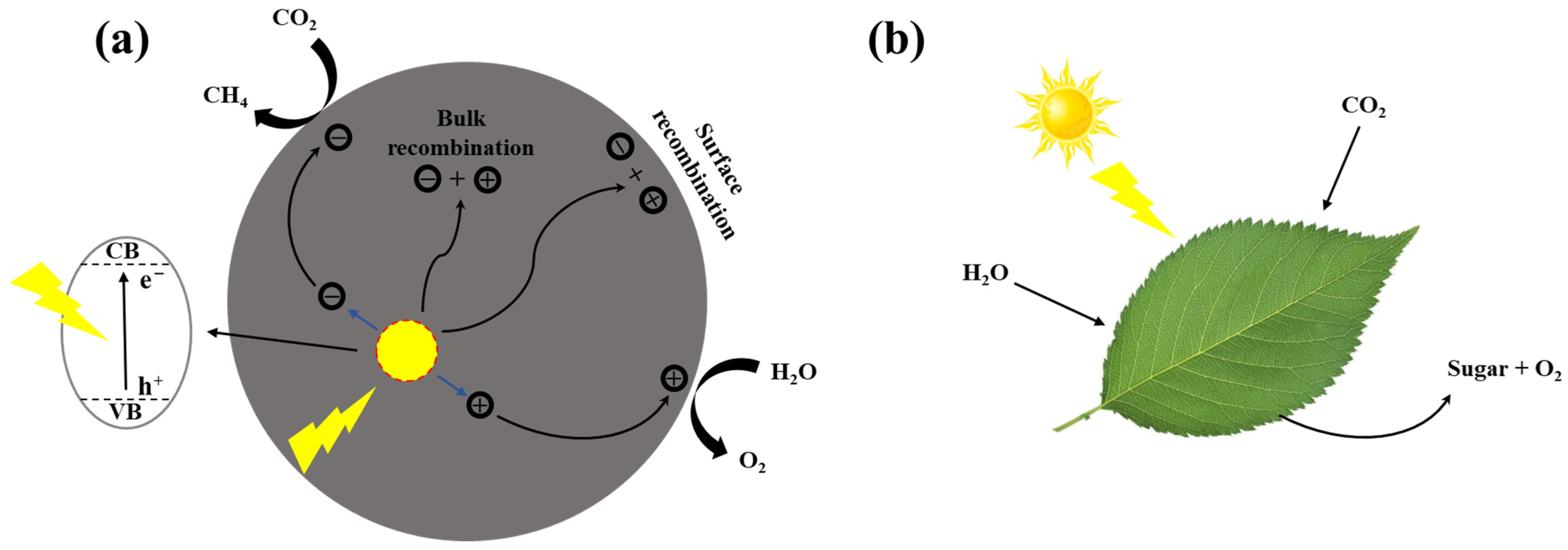


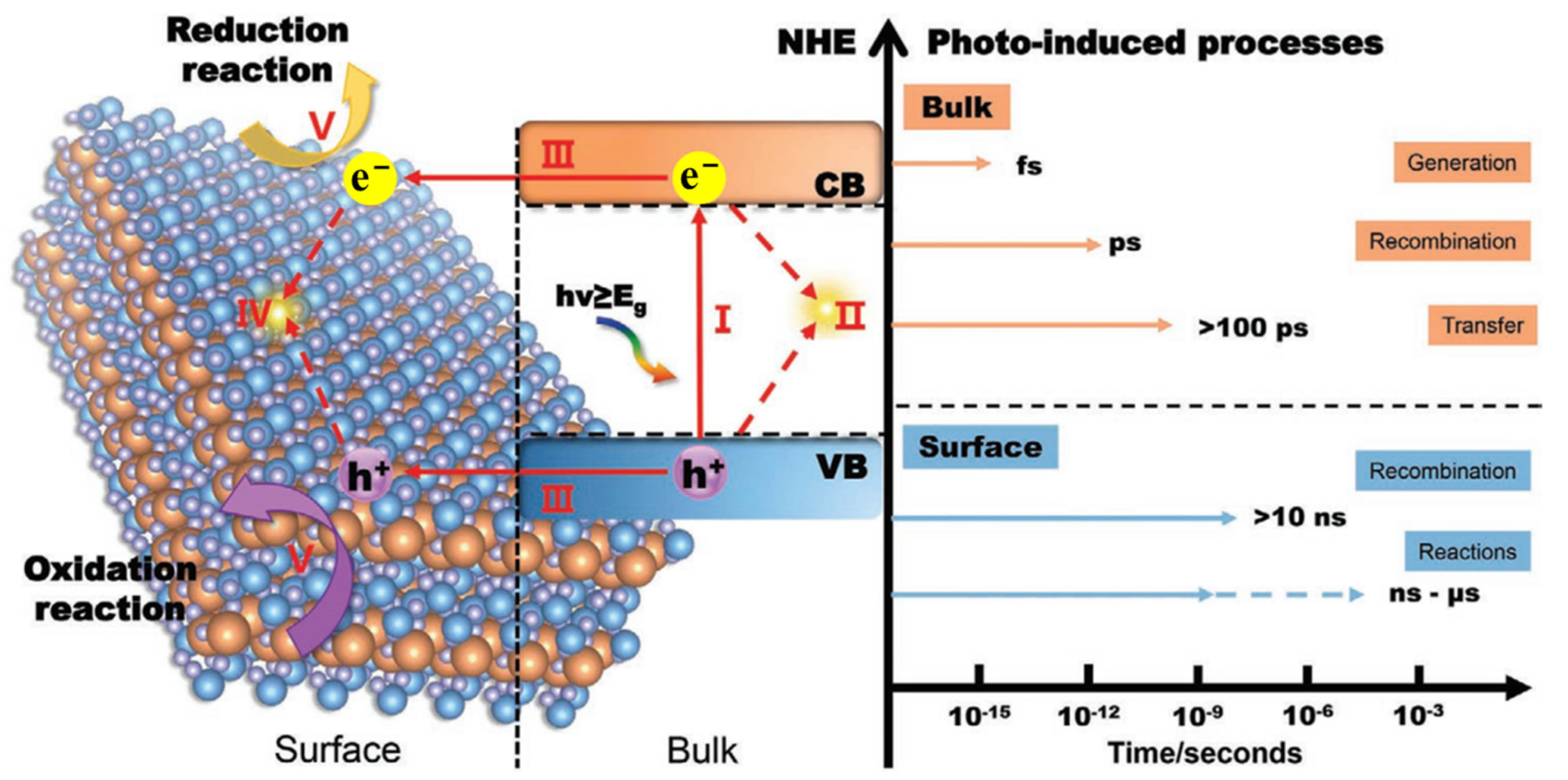

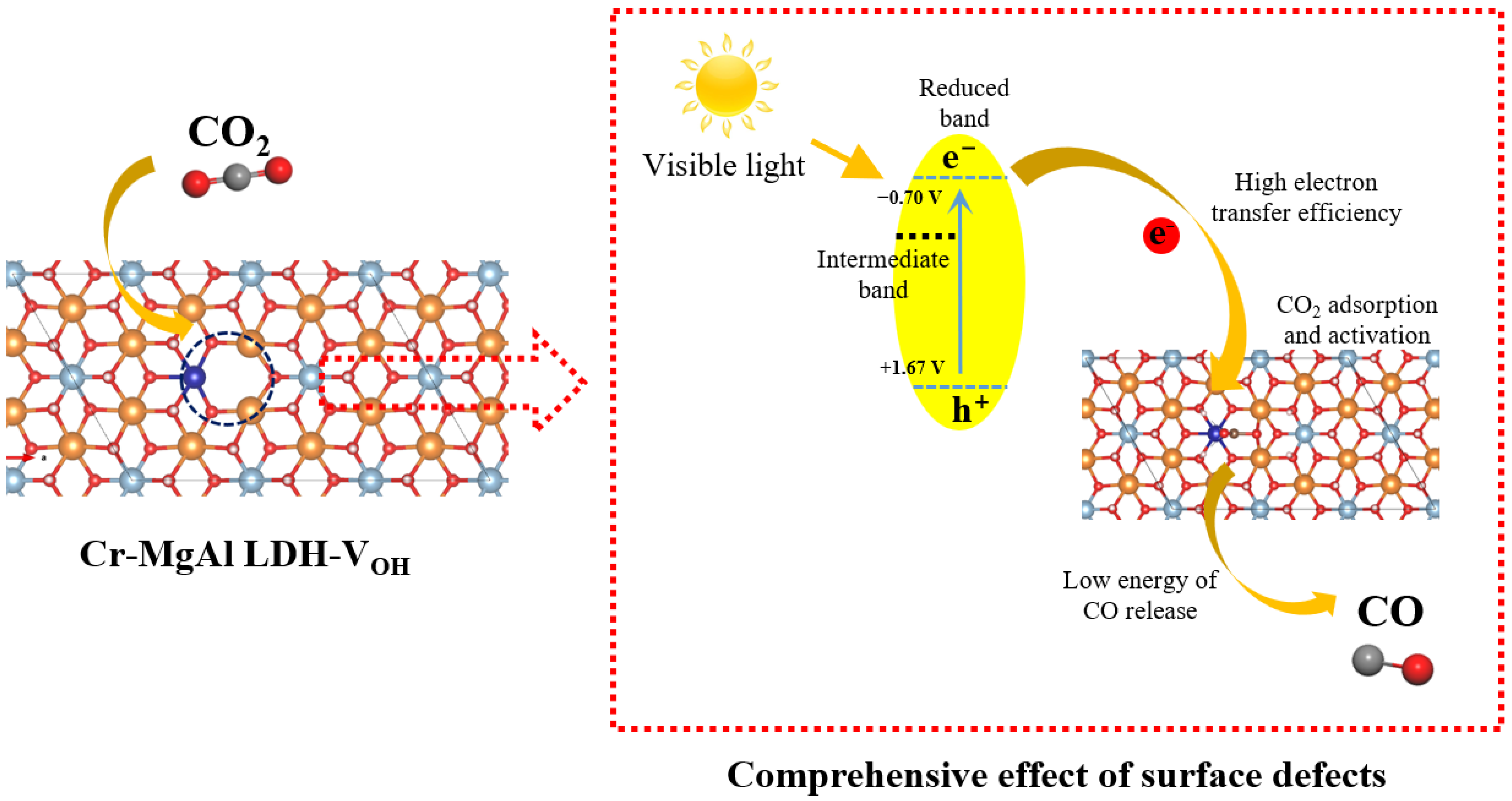
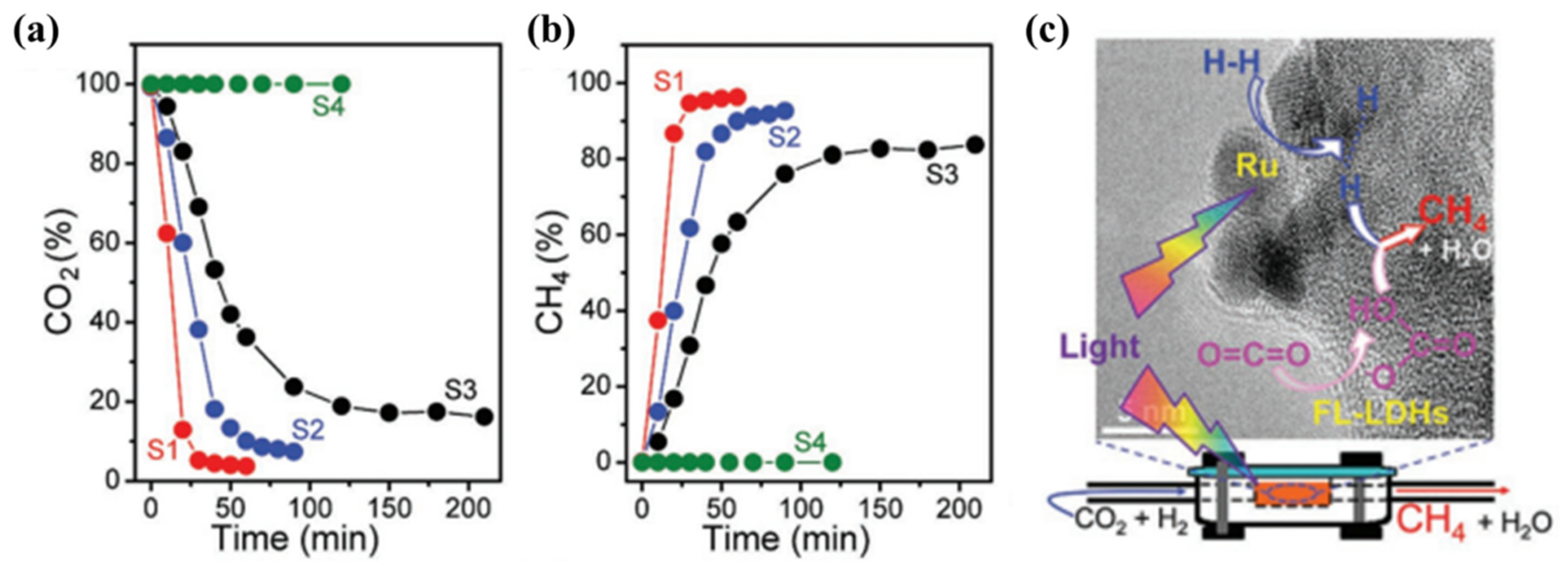


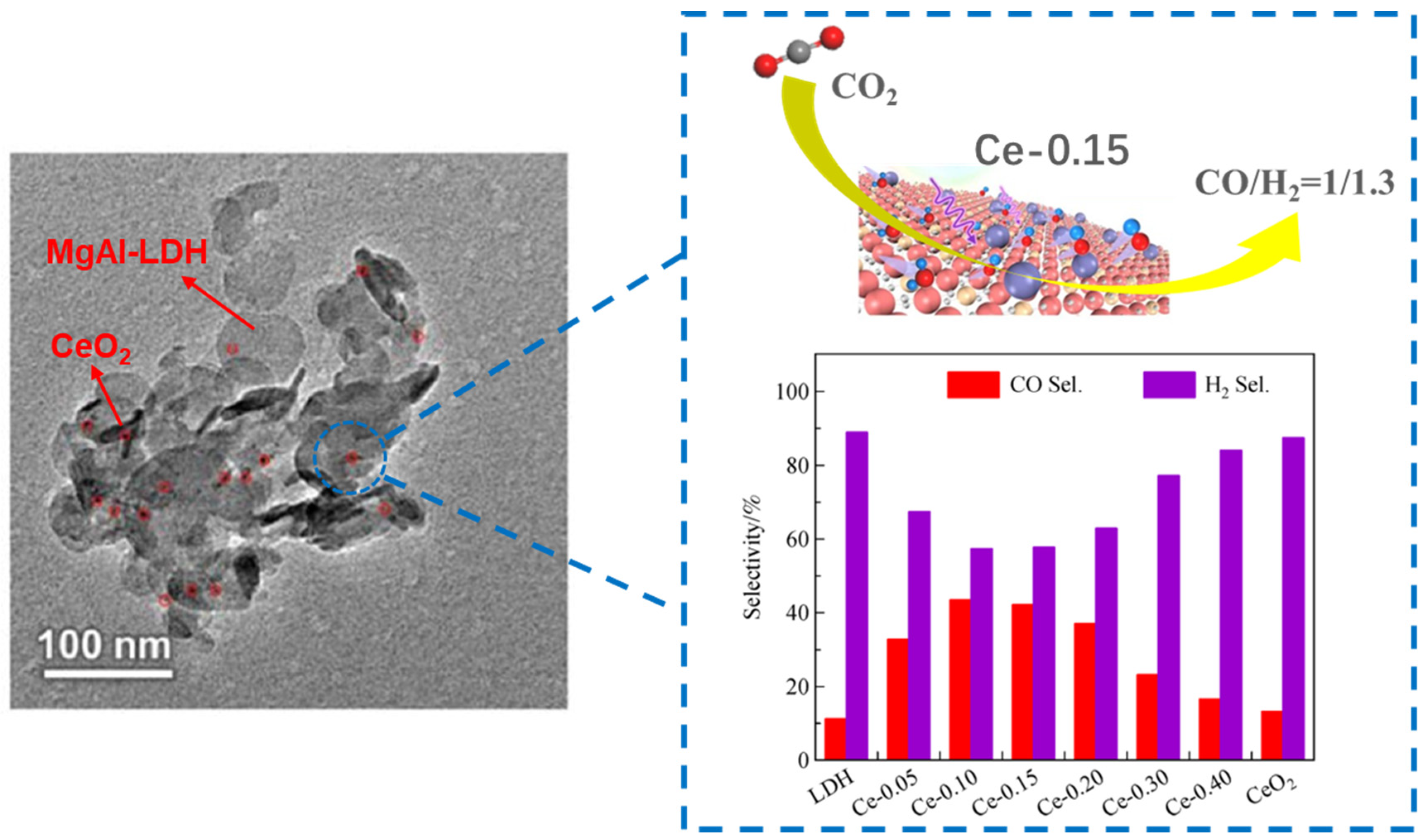
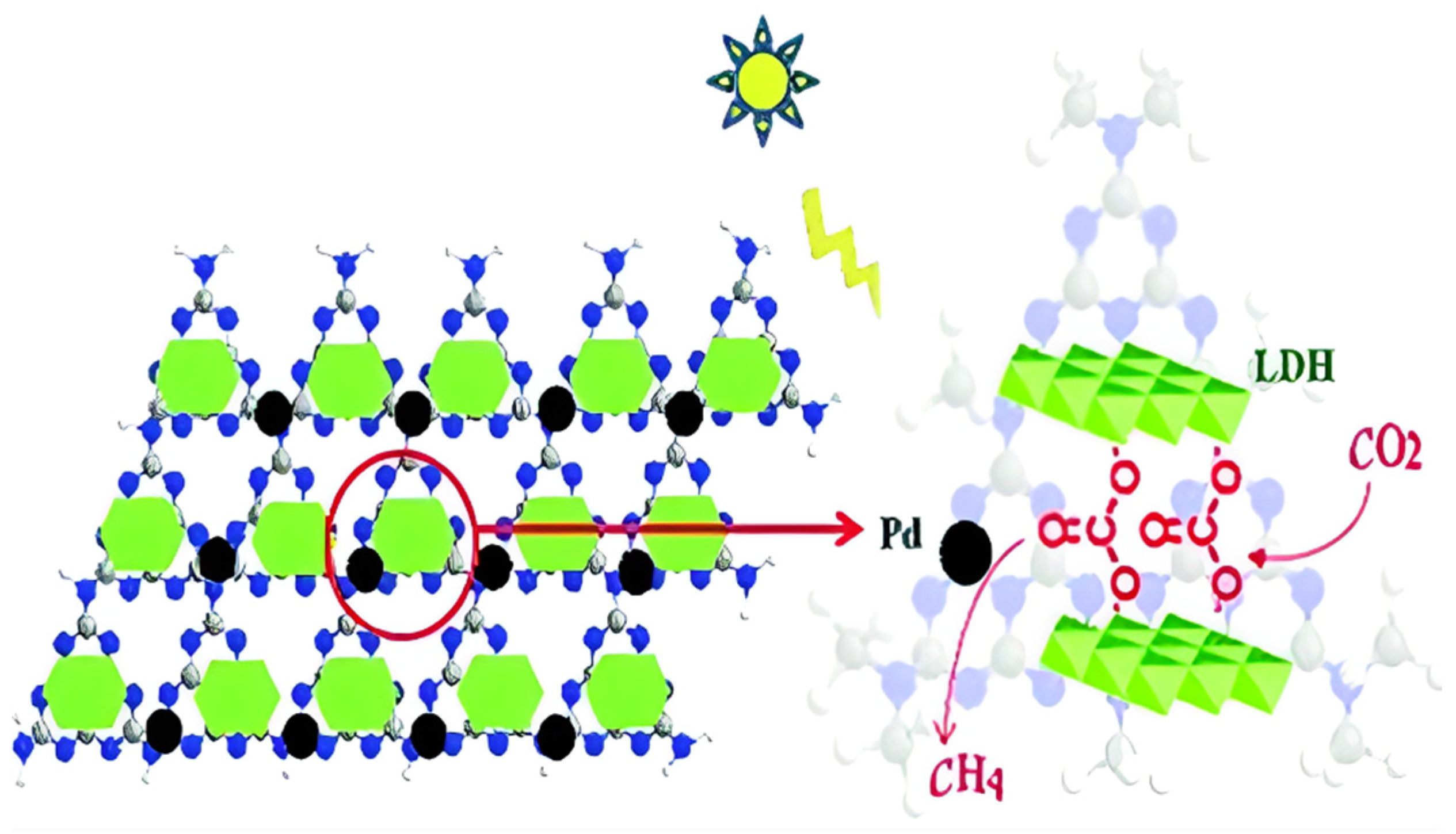
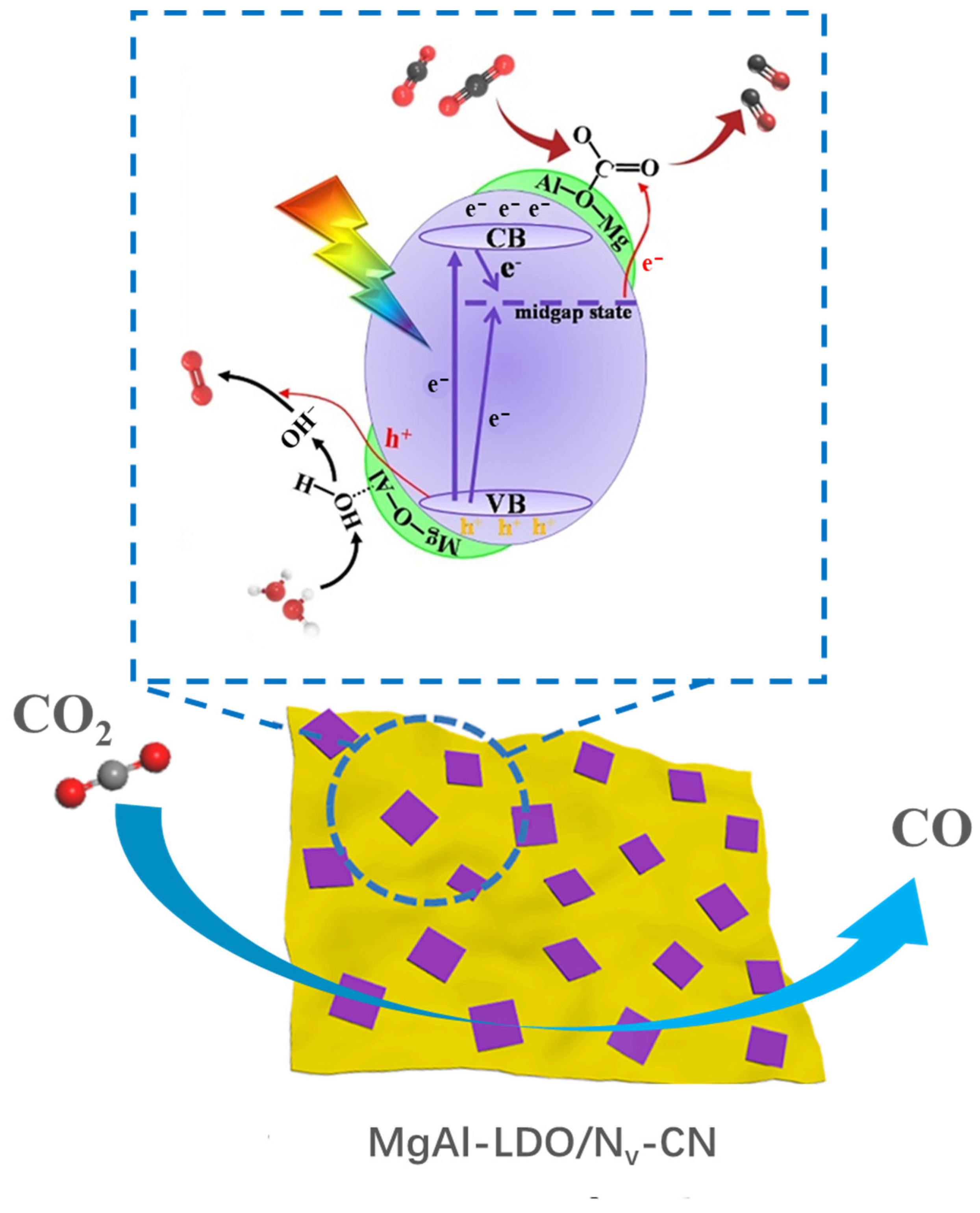
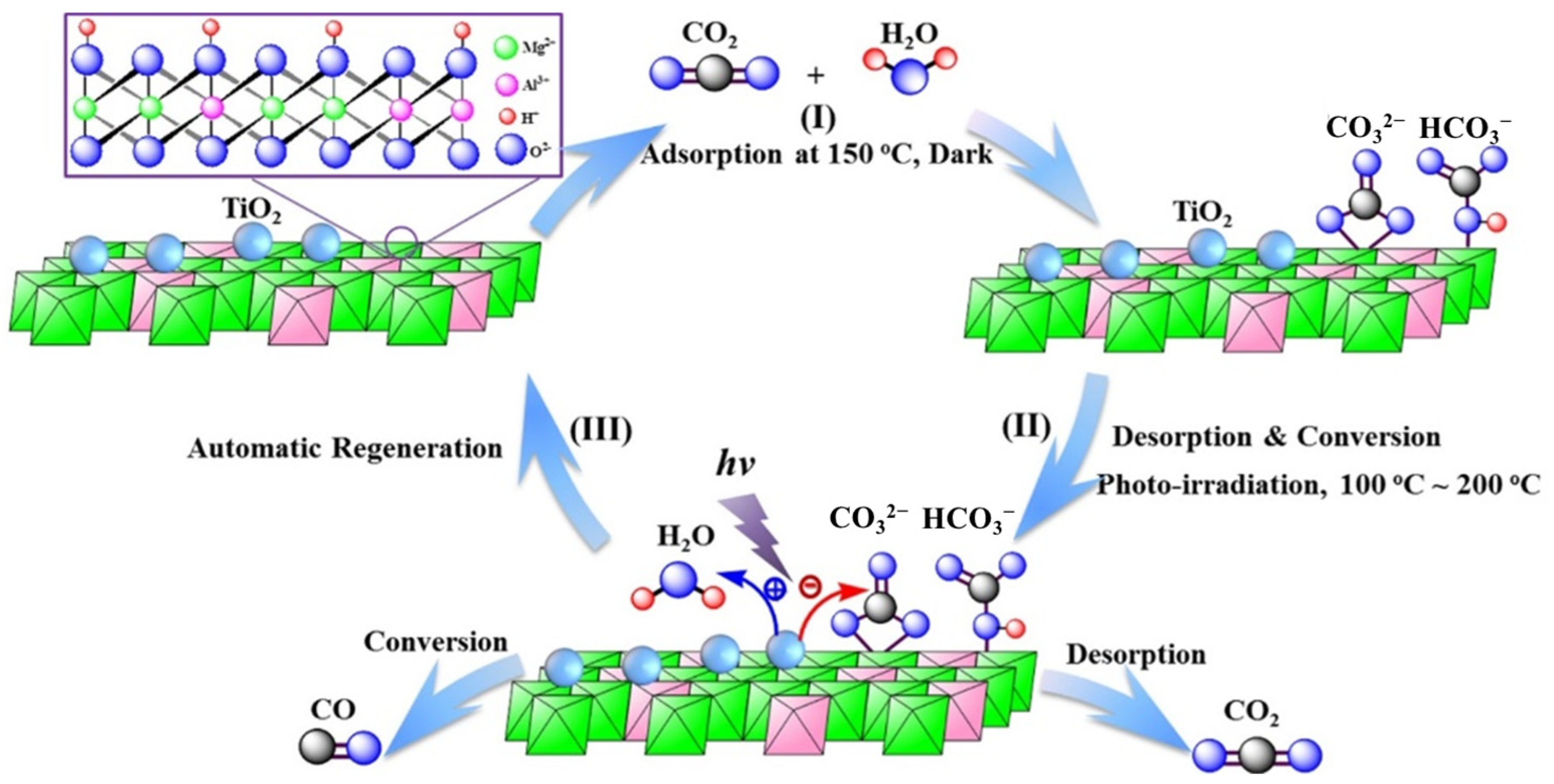
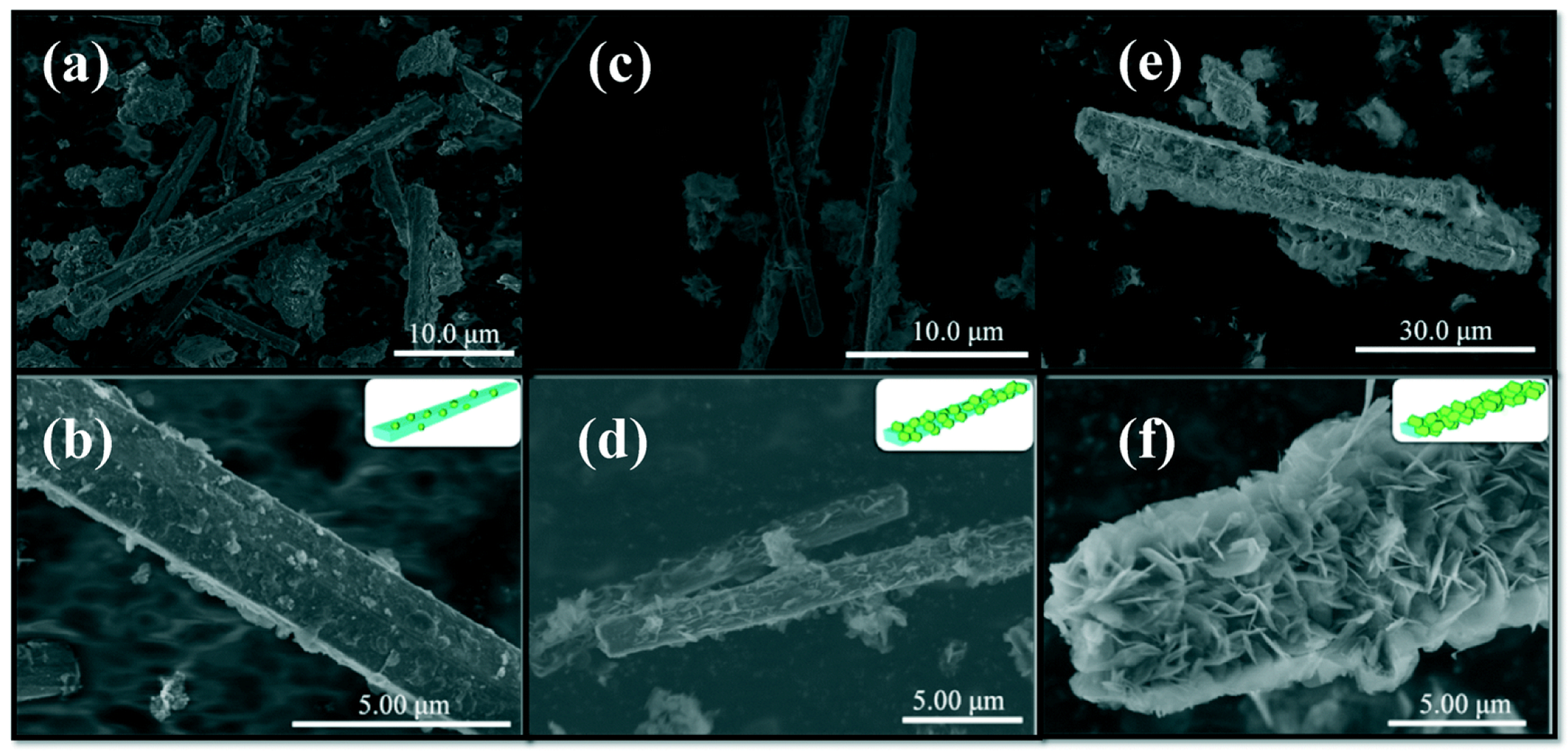
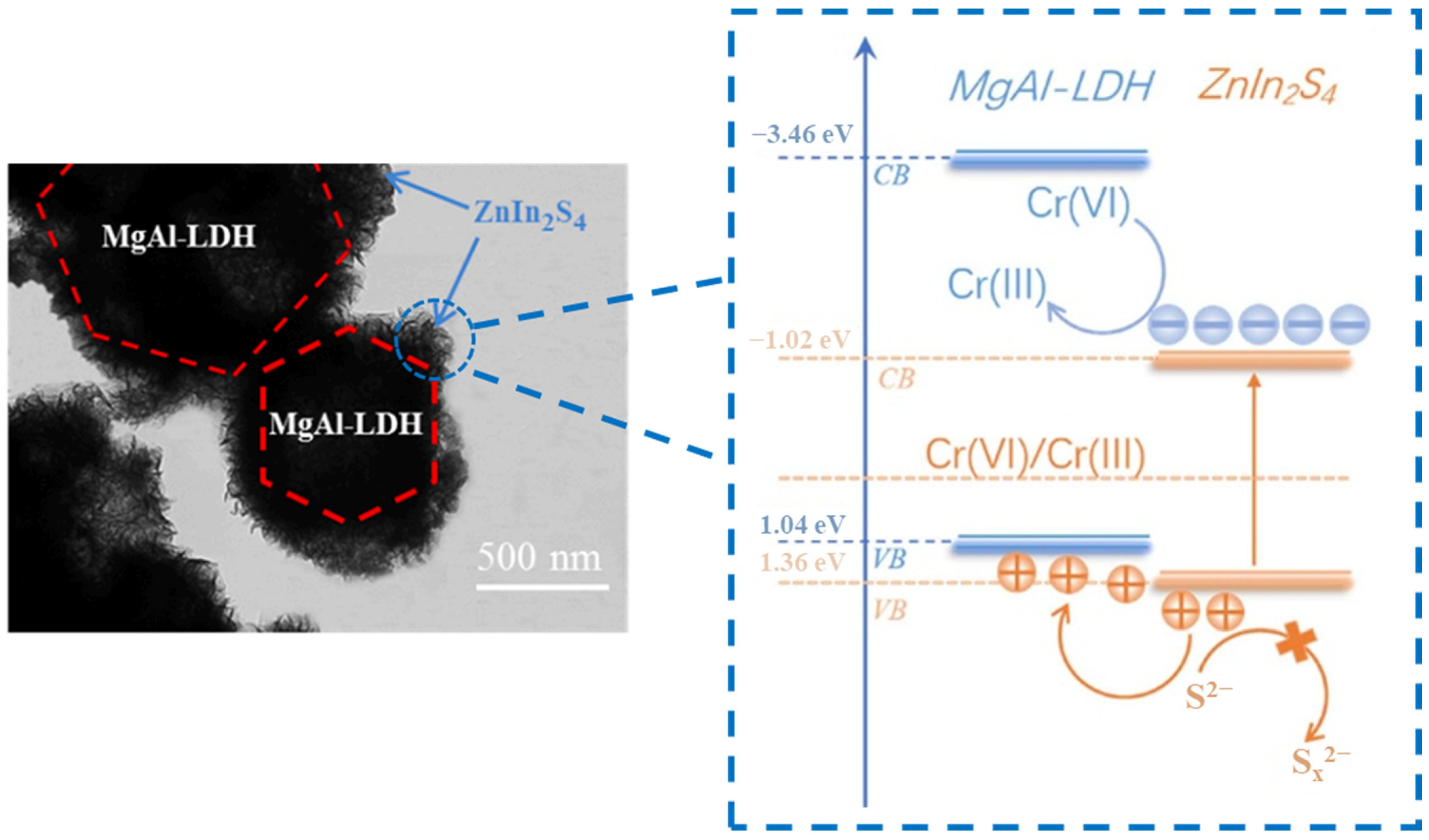
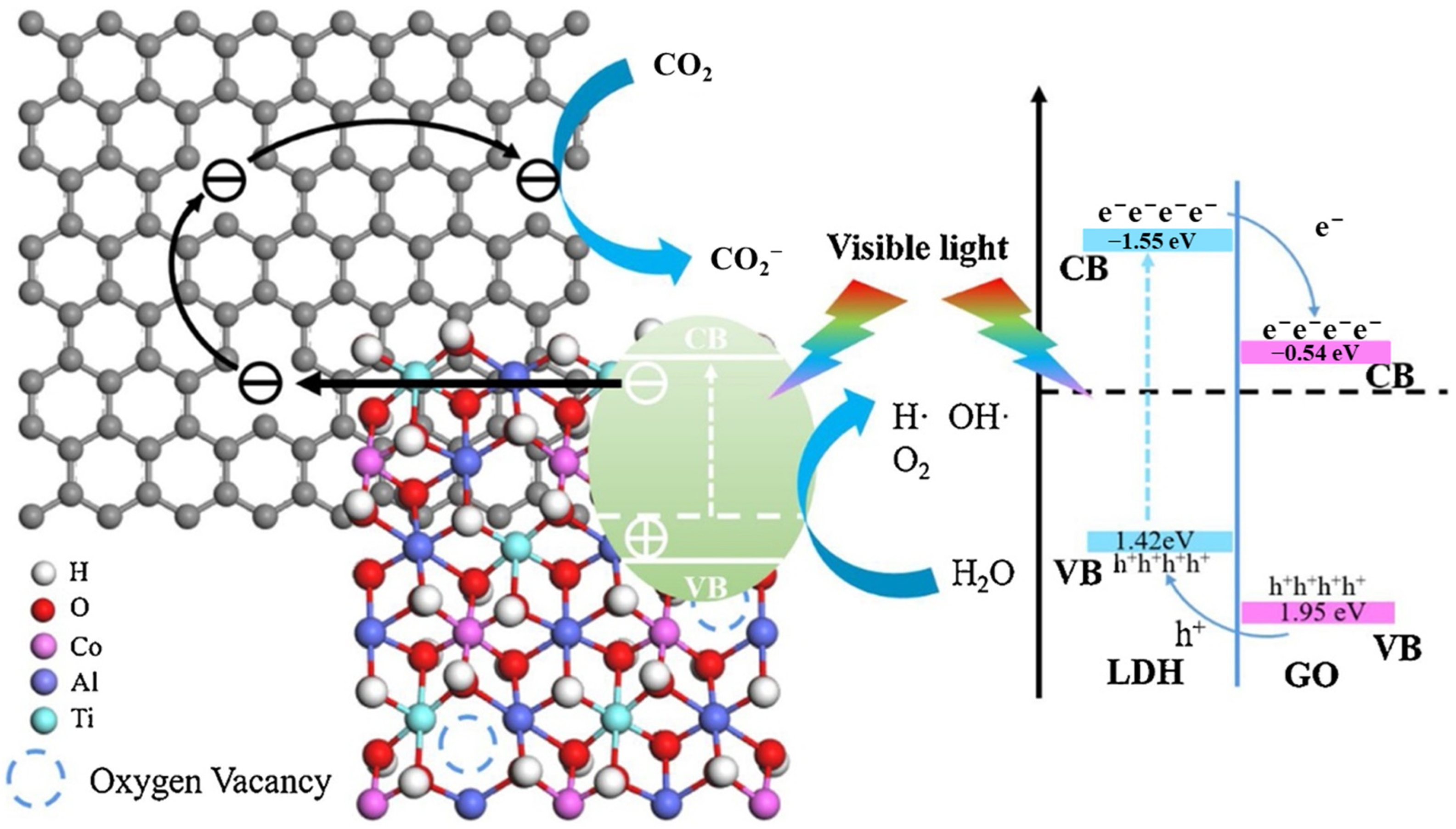
| No. | Reaction | Standard Redox Potential (V, NHE, pH = 7) |
|---|---|---|
| 1 | CO2 + e−→•CO2− | −1.90 |
| 2 | CO2 + 2H+ + 2e−→HCOOH | −0.61 |
| 3 | CO2 + 2H+ + 2e−→CO + H2O | −0.53 |
| 4 | CO2 + 4H+ + 4e−→HCHO + H2O | −0.48 |
| 5 | CO2 + 6H+ + 6e−→CH3OH + H2O | −0.38 |
| 6 | CO2 + 8H+ + 8e−→CH4 + 2H2O | −0.24 |
| 7 | 2CO2 + 12H+ + 8e−→C2H5OH + 3H2O | −0.16 |
| 8 | H2O + 2h+→1/2O2 + 2H+ | +0.82 |
| Structural Parameters | Value |
|---|---|
| Interlayer distance | 0.76 nm |
| Bandgap | 4.631 eV |
| Work function | 5.052 eV |
| CB referred to vacuum level | −0.617 eV |
| VB referred to vacuum level | −5.248 eV |
Publisher’s Note: MDPI stays neutral with regard to jurisdictional claims in published maps and institutional affiliations. |
© 2022 by the authors. Licensee MDPI, Basel, Switzerland. This article is an open access article distributed under the terms and conditions of the Creative Commons Attribution (CC BY) license (https://creativecommons.org/licenses/by/4.0/).
Share and Cite
Wang, C.; Xu, J.; Zhou, Z. A Mini-Review on CO2 Photoreduction by MgAl-LDH Based Materials. Energies 2022, 15, 8117. https://doi.org/10.3390/en15218117
Wang C, Xu J, Zhou Z. A Mini-Review on CO2 Photoreduction by MgAl-LDH Based Materials. Energies. 2022; 15(21):8117. https://doi.org/10.3390/en15218117
Chicago/Turabian StyleWang, Changqing, Jie Xu, and Zijian Zhou. 2022. "A Mini-Review on CO2 Photoreduction by MgAl-LDH Based Materials" Energies 15, no. 21: 8117. https://doi.org/10.3390/en15218117
APA StyleWang, C., Xu, J., & Zhou, Z. (2022). A Mini-Review on CO2 Photoreduction by MgAl-LDH Based Materials. Energies, 15(21), 8117. https://doi.org/10.3390/en15218117







